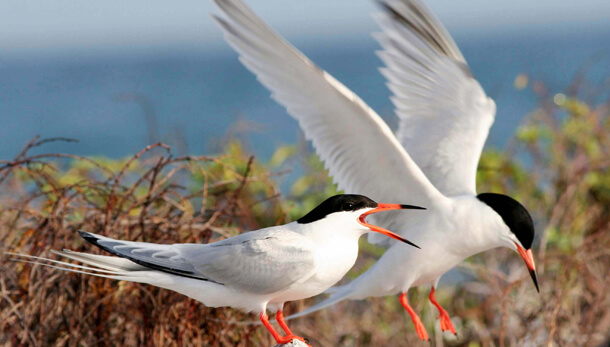Offshore Wind Development Threatens Endangered Roseate Tern
Contact: Michael Hutchins, 202-888-7485
(Washington, D.C. April 14, 2017) Anticipating increased mortality to the Endangered Roseate Tern from planned offshore wind development on the Atlantic coast, conservation groups are asking federal agencies to take steps to protect the remaining population of these already threatened birds. American Bird Conservancy (ABC) and several other national and regional conservation organizations have submitted a letter to federal authorities expressing their concerns.

Roseate Terns are threatened by offshore wind development along the Eastern Seaboard. Photo by Alcides Morales.
The birds' range and behavior make them especially vulnerable to harm from offshore wind energy facilities. “The federally Endangered Roseate Tern migrates and forages far off the coast during breeding season, putting it at risk from collisions with the rapidly spinning turbine blades,” said Dr. Michael Hutchins, Director of ABC's Bird-Smart Wind Energy Program. “We need to see how projected offshore wind energy development will affect this species, and how unavoidable impacts can be minimized.”
The Roseate Tern migrates the length of the Eastern Seaboard, which means it could be impacted by large-scale industrial offshore wind development that has been proposed by the U.S. Department of the Interior's Bureau of Ocean Energy Management off the coasts of South Carolina, North Carolina, Virginia, Maryland, Delaware, New Jersey, New York, Connecticut, Massachusetts, and Maine.
“Environmental Impact Statements and consultation with the U.S. Fish and Wildlife Service will likely be required for every project,” Hutchins said. “The large Cape Wind Project was halted off the coast of Massachusetts in part because of concerns over this and other federally protected species.”
As with any wind energy development, siting of these projects is critical. “Hundreds of thousands of birds and bats are being lost annually to onshore wind facilities, and offshore wind, if poorly placed, has the potential to be just as destructive,” Hutchins said. “At the very least, seasonal shutdowns should be required mitigation, since the terns' distribution and behavior is predictable.”
Roseate Terns already face a number of serious threats to their survival. According to the 1987 decision to list the species under the Endangered Species Act, “Nesting habitat for the northeastern North America population has been greatly reduced by housing developments and other human activity on or near the coastal barrier islands.” Predation and loss of prime nesting areas to more aggressive gulls also appear to be limiting recovery of this population.
“Given the terns' very small population and the limited amount of suitable habitat available, any new sources of mortality are of great concern,” said Hutchins. “The National Oceanic and Atmospheric Administration and U.S. Fish and Wildlife Service have been conducting studies on the tern's distribution since 2010. This information should be released to the public soon as promised so that the risks and impacts of proposed wind energy developments can be better assessed.”
###
American Bird Conservancy is dedicated to conserving birds and their habitats throughout the Americas. With an emphasis on achieving results and working in partnership, we take on the greatest problems facing birds today, innovating and building on rapid advancements in science to halt extinctions, protect habitats, eliminate threats, and build capacity for bird conservation.


















































